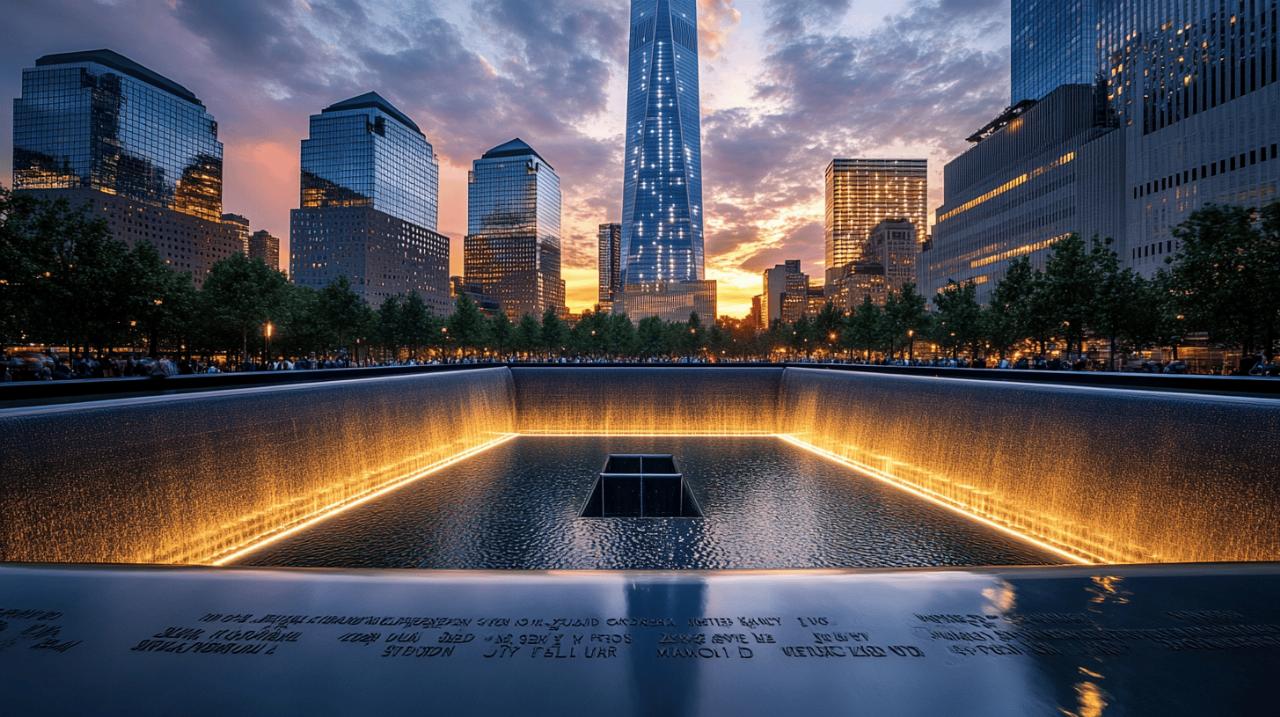In the heart of Lower Manhattan stands a powerful testament to resilience and remembrance, a place where history speaks through cascading water and bronze inscriptions. The 9/11 Memorial and Ground Zero represent far more than physical structures; they embody a collective commitment to honouring those lost whilst understanding the profound lessons that emerged from one of the most devastating terrorist attacks in modern history. Visiting this site offers an opportunity not only to reflect upon the events that unfolded on that September morning but also to consider how such tragedies have reshaped global approaches to security, vigilance, and unity in an increasingly complex world.
Understanding the 9/11 Memorial: A Place of Remembrance and Reflection
Spanning eight acres of the sixteen-acre World Trade Center site, the 9/11 Memorial emerged from an international design competition that attracted over five thousand submissions from sixty-three countries. The winning concept, titled Reflecting Absence, was crafted by Michael Arad and landscape architect Peter Walker. Their vision transformed the footprints of the former North and South Towers into twin waterfall pools, each featuring the largest man-made waterfalls in North America. Water descends thirty feet into a square basin before plunging another twenty feet into a central void, creating a mesmerising and contemplative spectacle that draws visitors into quiet introspection.
The Architecture and Symbolism of the Reflecting Pools
The design of these reflecting pools serves as a profound metaphor for loss and absence. The cascading water moves continuously, symbolising the passage of time and the enduring nature of memory. Surrounding the pools, an eight-acre plaza features more than four hundred swamp white oak trees, creating a serene canopy that offers respite from the bustling city. Among these trees stands the Survivor Tree, a Callery pear tree that was discovered damaged yet alive amidst the rubble of Ground Zero. Nursed back to health, this tree has become an emblem of resilience and hope, its recovery mirroring the spirit of those who endured the aftermath of the attacks. Each year, seedlings from the Survivor Tree are gifted to communities worldwide that have faced terrorism, violence, or natural disasters, spreading a message of strength and renewal far beyond Manhattan.
Honouring the Victims: Names Etched in Bronze
Bronze parapets encircle the reflecting pools, bearing the names of all 2,983 victims from both the 2001 attacks and the 1993 World Trade Center bombing. These inscriptions are not arranged alphabetically; instead, they are grouped according to meaningful adjacencies, placing names of friends, colleagues, and crew members alongside one another. This thoughtful arrangement acknowledges the bonds that connected these individuals in life, offering families and visitors a deeply personal way to honour their memory. The Memorial Glade, which opened on the thirtieth of May 2019, further extends this tribute. Featuring stone monoliths embedded with steel from the original towers, it honours rescue and recovery workers who fell ill or died from exposure to toxins during the months following the attacks, recognising their sacrifices during the seventeen-month recovery period.
Inside the 9/11 Museum: A Journey Through History and Resilience
Located at 180 Greenwich Street, the 9/11 Museum delves beneath the memorial plaza to offer a comprehensive examination of the events surrounding that fateful day. Open from Wednesday to Monday, nine in the morning until seven in the evening, with select Tuesday and holiday hours, the museum provides an emotionally charged yet respectful exploration of loss, recovery, and hope. Through multimedia displays, personal stories, and authentic artefacts, visitors gain insight into the experiences of those who lived through the attacks, from survivors and families to first responders and recovery personnel.
Exhibits and Artefacts: Telling the Story of That Fateful Day
Within the museum, exhibits showcase items such as crushed vehicles, twisted steel beams, and personal belongings recovered from the site. These tangible remnants serve as stark reminders of the destruction wrought that morning, yet they also illustrate the incredible acts of courage and compassion that emerged in response. Educational programmes and resources are available for students, teachers, families, and the general public, ensuring that future generations understand not only the scale of the tragedy but also the enduring lessons it imparts. The museum actively engages with families of victims, survivors, and rescue workers, fostering a space where personal narratives are honoured and shared, creating a bridge between past and present.
Planning your visit: tickets, tours, and accessibility
To fully appreciate the depth of the memorial and museum, advance booking is advisable, particularly given the high volume of visitors. Tours led by knowledgeable guides offer deeper context and insights, enriching the experience with detailed accounts and historical background. For those with mobility concerns, the site is fully accessible, with wheelchairs readily available to ensure everyone can engage with the space comfortably. The memorial itself is open daily from eight in the morning until eight in the evening, providing ample opportunity for quiet reflection. Whether visiting independently or as part of a guided group, the experience is designed to be both informative and profoundly moving, encouraging contemplation of the human capacity for both destruction and healing.
Exploring lower manhattan: beyond ground zero
 Whilst the 9/11 Memorial and Museum form the emotional centrepiece of a visit to Lower Manhattan, the surrounding area offers a wealth of cultural and historical attractions. A day spent exploring this vibrant neighbourhood can encompass iconic landmarks, stunning vistas, and enriching cultural experiences, making it a comprehensive outing for visitors seeking to understand New York's past and present.
Whilst the 9/11 Memorial and Museum form the emotional centrepiece of a visit to Lower Manhattan, the surrounding area offers a wealth of cultural and historical attractions. A day spent exploring this vibrant neighbourhood can encompass iconic landmarks, stunning vistas, and enriching cultural experiences, making it a comprehensive outing for visitors seeking to understand New York's past and present.
Iconic Landmarks: Statue of Liberty, Ellis Island, and One World Observatory
A ferry trip to the Statue of Liberty and Ellis Island remains a quintessential New York experience, offering insight into the waves of immigration that shaped the city and the nation. Returning to Lower Manhattan, One World Observatory provides spectacular panoramic views from the top of One World Trade Centre, also known as the Freedom Tower. Soaring to 1,776 feet in height, a deliberate reference to the year of American independence, this building stands as a symbol of renewal and resilience. From its observation deck, visitors can glimpse other iconic structures such as the Empire State Building, gaining a sense of the city's architectural grandeur and historical continuity. For those seeking a different perspective, Summit One Vanderbilt offers equally impressive vistas, showcasing the dynamism of modern Manhattan.
Cultural Gems and Modern Marvels: MoMA and Summit One Vanderbilt
Art enthusiasts will find the Museum of Modern Art, known affectionately as MoMA, within easy reach of the memorial. This world-renowned institution houses an extraordinary collection of contemporary and modern works, providing a counterpoint to the historical gravity of Ground Zero. Meanwhile, Summit One Vanderbilt represents a newer addition to the city's skyline, offering innovative exhibits and breathtaking views that highlight the forward momentum of urban development. Together, these attractions create a rich tapestry of experiences, allowing visitors to engage with both the sombre lessons of history and the vibrant energy of a city that continues to evolve.
Lessons from Tragedy: Preparing for the Future of Terrorism
Beyond its role as a site of remembrance, the 9/11 Memorial serves as a powerful catalyst for broader discussions about security, counter-terrorism, and the collective responsibility to prevent future atrocities. The events of September 2001 fundamentally altered the landscape of global security, prompting nations to reassess their vulnerabilities and develop more robust strategies for protecting citizens. Understanding the historical context of that day and the subsequent response is essential for appreciating the ongoing challenges posed by terrorism in an interconnected world.
The Global Impact of 9/11 on Security and Counter-Terrorism
The attacks prompted sweeping changes in international security protocols, from airport screening procedures to intelligence sharing among nations. Governments invested billions in infrastructure and technology designed to detect and thwart potential threats before they materialise. The reconstruction of the World Trade Center site itself reflects this commitment to resilience. The Freedom Tower, designed by David Childs of Skidmore, Owings and Merrill, features reinforced structures and advanced safety systems, symbolising a determination to rebuild whilst incorporating lessons learned from tragedy. Other buildings on the site, including Tower Four by Fumihiko Maki and Tower Three by Rogers Stirk Harbour and Partners, contribute to a revitalised skyline that honours the past whilst embracing the future. The transport interchange designed by Santiago Calatrava further underscores the site's role as a hub of activity and connectivity, demonstrating that renewal can coexist with remembrance.
Remembering to Move Forward: The Importance of Vigilance and Unity
The memorial and museum emphasise that honouring the victims requires more than passive reflection; it demands active engagement with the values of vigilance, compassion, and unity. The Survivor Tree and the Memorial Glade stand as enduring symbols of resilience, reminding visitors that recovery is possible even in the face of profound loss. By connecting with families, survivors, and rescue workers, the institution fosters a sense of shared purpose, encouraging ongoing dialogue about how communities can support one another in times of crisis. The project faced considerable challenges, including political infighting and debates over the balance between commercial development and respectful commemoration. Ultimately, the site represents a compromise, blending public spaces for reflection with commercial office space required by Larry Silverstein, who leased the towers before the attacks. Funded by billions of public dollars and private investment, the project illustrates the complexities of rebuilding in a manner that satisfies diverse stakeholders whilst maintaining the integrity of the memorial. As visitors walk through the plaza, surrounded by the names of the fallen and the sound of cascading water, they are invited to consider their own role in fostering a safer, more compassionate world, ensuring that the lessons of September eleventh continue to resonate for generations to come.





